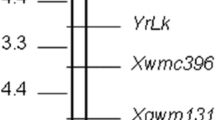Summary
The mode of inheritance of resistance to stripe rust in wild emmer was studied in a series of crosses between Triticum dicoccoides sel. G-25-highly resistant to Puccinia striiformis race 20A-and susceptible cultivars of T. aestivum.
In direct crosses between the T. dicoccoides selection and the susceptible T. aestivum cultivars, the pentaploid interspecific hybrids were highly sterile (fertility of 1–2% by self-pollination); the F2 population segregated in a 3 resistant:1 susceptible ratio.
In bridge-crosses between the fertile tetraploid progeny of a previous T. dicoccoides-T. durum cross and susceptible T. aestivum cultivars, the fertility was markedly improved (approximately 50% when T. aestivum served as pollinator); the F1 pentaploid hybrids of these three-way crosses segregated in a pattern fitting a 1 resistant:1 susceptible ratio.
Results obtained by both of these methods thus prove that a single dominant gene for resistance to stripe rust was transferred from T. dicoccoides sel. G-25 to the susceptible T. aestivum cultivars.
In a further cross between T. dicoccoides sel. G-25 and resistant T. aestivum cv. Florence Aurore 8193-the main source of resistance to stripe rust in our wheat-breeding program-the high degree of sterility in the pentaploid interspecific hybrids was overcome by exposing the F1 progeny to open mass-pollination, with Florence Aurore as recurrent parent (seed-set of 1–5%); segregation for stripe rust reaction in the second hybrid generation indicates that a different gene operates in each of the two parents.
The F6 populations obtained from crosses between T. dicoccoides sel. G-25 and both susceptible and resistant cultivars of T. aestivum have a high degree of fertility and are considered a valuable stock for wheat breeding.
Similar content being viewed by others
References
Ephrat J. & Adriana Grama, 1965. Preliminary results in crosses between dwarf common wheat (Triticum aestivum) varieties and durum wheat (Triticum durum). Proc. XIII Meeting of the Genetics Society of Israel. Israel J. agric. Res. 15 (2): 107 (Abstr.)
Gerechter-Amitai, Z. K. & Adriana Grama, 1974. Inheritance of resistance to stripe rust (Puccinia striiformis) in crosses between wild emmer (Triticum dicoccoides) and cultivated tetraploid and hexaploid wheats. I. Triticum durum. Euphytica 23: 000–000.
Gerechter-Amitai, Z. K. & R. W. Stubbs, 1970. A valuable source of yellow rust resistance in Israeli populations of wild emmer, Triticum dicoccoides Koern. Euphytica 19: 12–21.
Gerechter-Amitai, Z. K., I. Wahl, Aliza Vardi, & D. Zohary, 1971. Transfer of stem rust seedling resistance from wild diploid einkorn to tetraploid durum wheat by means of a triploid hybrid bridge. Euphytica 2: 281–285.
Vardi Aliza & D. Zohary, 1967. Introgression in wheat via triploid hybrids. Heredity 22: 541–560.
Author information
Authors and Affiliations
Additional information
Contribution from the Agricultural Research Organization, The Volcani Center, Bet Dagan, Israel. 1973 Series, No. 293-E.
Rights and permissions
About this article
Cite this article
Grama, A., Gerechter-Amitai, Z.K. Inheritance of resistance to stripe rust (Puccinia striiformis) in crosses between wild emmer (Triticum dicoccoides) and cultivated tetraploid and hexaploid wheats. II. Triticum aestivum . Euphytica 23, 393–398 (1974). https://doi.org/10.1007/BF00035884
Received:
Issue Date:
DOI: https://doi.org/10.1007/BF00035884



